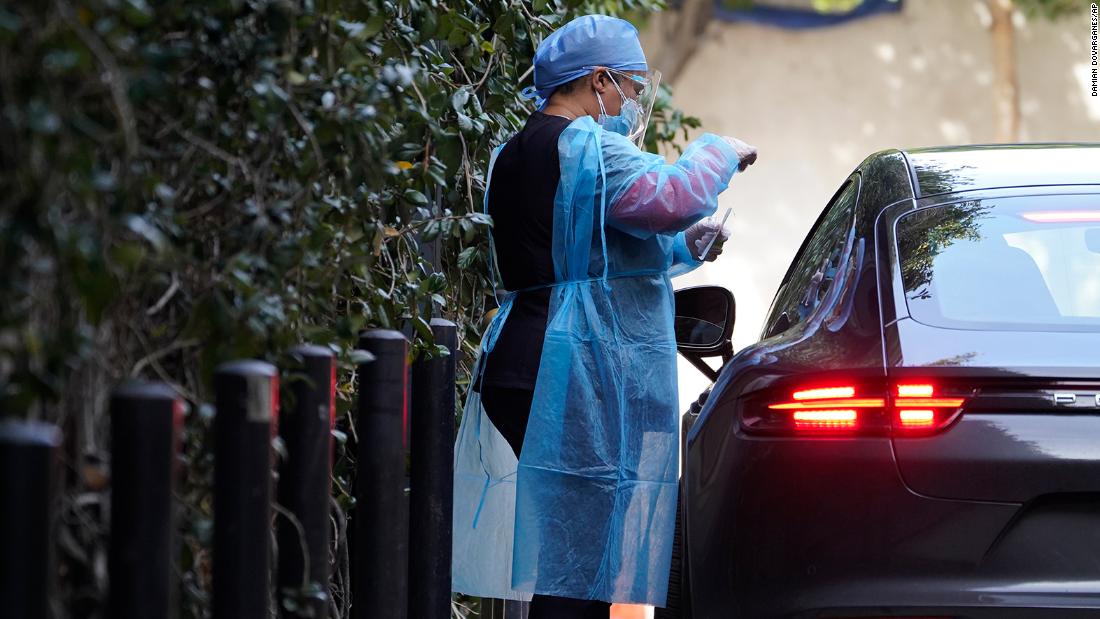
American Coronavirus: At this rate, January will be the deadliest month for Covid-19 in the United States
But it took only 10 days to reach 2.2 million cases in 2021, according to data from Johns Hopkins University.
New infections, hospitalizations and deaths continue to rise.
“We are in a difficult situation,” said Dr. Ashish Jha, dean of the School of Public Health at Brown University.
“We know how to slow the spread of the virus. We need mandates with masks. We need people to really stay home and avoid any indoor gatherings.”
But officials say many Americans have done the opposite during the holidays, gathering with friends or extended family – the consequences are now more evident in overcrowded hospitals across the country.
A more lethal pace than 2020
More than 27,000 new Covid-19 deaths were reported in just the first ten days of 2021, according to data from Johns Hopkins.
At this rate, more people could die from Covid-19 in January than in any other month due to this pandemic. December recorded a record 77,431 Covid-19 deaths.
On Saturday, the United States suffered 3,655 new COVID-19 deaths, along with 269,623 new infections, according to Johns Hopkins.
Joe K. Gerald, associate professor at the Zuckerman School of Public Health at the University of Arizona, says the crisis will only get worse in the hard-hit state of Arizona.
“We should expect new records for cases, hospitalizations, and deaths in the coming weeks,” Gerald wrote. “There is an urgent need for political action to mitigate the worst possible outcomes.”
“If you gain a foothold, it will accelerate, prolong and deepen the Arizona outbreak,” Gerald said.
The number of victims could worsen as more hospitals fill up.
There were 129,229 Covid-19 patients in US hospitals on Sunday, according to the COVID-19 Tracking Project – the sixth highest number on record. It was the 40th day in a row that the number of Covid-19 entries in the United States remained above 100,000.
Then these individuals all go in cars, trains, and planes to their homes all over the country now.
CNN’s medical analyst and emergency physician, Dr. Lena Wayne, echoed the statement, saying Anna Cabrera of CNN on Sunday, “Individuals who have not used masks or social distancing on the Capitol may not follow these guidelines when they return to their communities.”
“And it is very likely that they are engaging in other risky behaviors out there and potentially spreading the Coronavirus across the country, wherever they come,” she said. “I hope that everyone who participated in these events will return to quarantine and undergo examinations.”
“Our most dangerous time”
In Kentucky, Kentucky Governor Andy Bashir said his state is seeing “a real and substantial increase in cases and our rate of positivity from public gatherings around the holiday.”
“This increase, which we are in now, is at least twice the rate and severity of the previous increases that we have seen,” the governor said on Friday. “This is our most dangerous time.”
Hospitalizations are escalating in Texas, with a record number of Covid-19 patients reported for a seventh consecutive day on Saturday. At least 13,935 patients have been hospitalized in the state, according to the Texas Department of Health Services.
There were 7,497 Covid-19 patients in Florida hospitals on Sunday, according to the Florida Health Care Management Agency. That’s nearly 3,000 more patients than the state’s hospitalization has been about a month ago, on December 12, when AHCA reported 4,343 hospitalizations.
California set two new records on Saturday – the largest number of deaths reported in one day, 695, and most Covid-19 patients in intensive care units – 4,939. On Sunday, the state recorded nearly 50,000 new infections and 468 deaths.
“The speed with which we are reaching bleak stages of COVID-19 deaths and cases is a devastating reflection of the massive spread that is happening across the county,” said Barbara Ferrer, director of public health for Los Angeles County.
She said: “The best way to protect ourselves, slow the spread of disease, and stop flooding our hospitals, is to temporarily stop participating in any activities that are not absolutely necessary.”
“This is not the time to go to the shopping center or to a friend’s house to watch a basketball or football match.”
The Biden team announces a plan to accelerate the rollout of the vaccine
Meanwhile, Dr. Megan Rani, CNN’s medical analyst and emergency physician, said the introduction of the Covid-19 vaccine in the country “is not working at all as planned.”
“We have three times the doses distributed to the states that have already been distributed,” she said. “We have to do something different, and we have to do something different now.”
But it could also be risky, because the Pfizer / BioNTech and Moderna vaccines require two doses weeks apart to be 95% effective, and vaccine manufacturing has not been ramped up as quickly as many experts had hoped.
The plan is a departure from the Trump administration’s strategy, which has stopped doses of vaccines to ensure that second doses are available.
Dr. Celine Gunder, a member of Biden’s advisory board on coronavirus, told CNN on Saturday that the new plan aims to “get doses as quickly as possible” and simplify distribution.
She said officials are not advising patients to delay receiving their second dose. People should still plan to receive their second dose of Pfizer vaccine 21 days after the first dose, and Moderna vaccine 28 days after the first dose.
“As long as there is no manufacturing defect, we are confident that the vaccine supply will be in place when people return for their second dose,” Gunder said.
Rani said she believes the plan “makes sense,” saying the United States needs to “rethink how we take the doses we have and get them into the arms of people.”
She said, “Time is absolutely of the essence.” But she also stressed that people need to adhere to the two-dose regimen approved by the Food and Drug Administration.
When asked about the plan, Wen said that she supports any effort to speed up vaccination, “but we also have to look at where the bottleneck is.”
“At the moment, it’s not about a lot of supply, but it’s actually that last mile of getting (vaccines) from distribution sites to actually people’s arms,” she said. “If we have more supplies, that doesn’t actually solve the right problem.”
Wayne also said that everyone who got the first dose would be guaranteed to get a second dose in time, because that’s how the clinical trials were done.
And if there is not enough vaccine for people to receive second doses, she said, “I think that could really fuel the frequency of vaccinations and further erode the public’s confidence in these vaccines.”
Miguel Marquez, Holly Silverman, Christina Maxoris, Chuck Johnston, Kay Jones, Sherry Mossberg, Lauren Mascarenhas, Jason Hana and Dakin Andoni contributed to this report.

“Totale ninja voor sociale media. Introvert. Maker. Tv-fan. Bekroonde ondernemer. Webnerd. Gecertificeerde lezer.”
